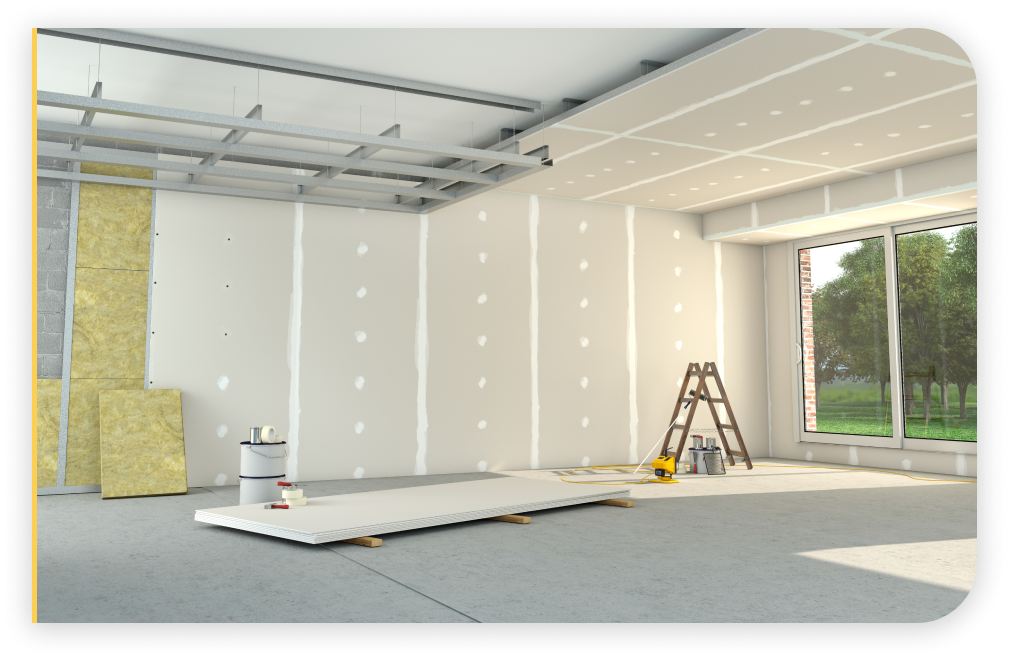November 28, 2023
In the ever-evolving realm of architecture, the use of drywall has become a staple for interior construction. This versatile material has garnered popularity for its ease of use and adaptability to various design concepts. In this blog, we’ll delve into the pros and cons of incorporating drywall into architectural projects.
PROS
Ease of Installation
Drywall is renowned for its straightforward installation process. Its lightweight nature makes it easy to handle, reducing both labour and time required for construction projects.
Versatility in Design
The smooth, uniform surface of drywall provides a versatile canvas for design. From minimalist aesthetics to intricate detailing, drywall adapts effortlessly to various styles, allowing architects to unleash their creativity.
Cost-Effective
Drywall is a cost-effective material compared to traditional construction methods. Its affordability makes it an attractive choice for projects with budget constraints.
Fire-Resistant Properties
Many drywall products are designed with fire-resistant properties, enhancing the safety of a structure. This feature is crucial for compliance with building codes and regulations.
Sound Insulation
Drywall contributes to sound insulation, creating a quieter and more comfortable indoor environment. This is especially beneficial in residential and commercial spaces.
CONS
Susceptibility to Water Damage
One of the primary drawbacks of drywall is its vulnerability to water damage. Moisture exposure can lead to mould growth and compromise the structural integrity of the material.
Not Ideal for Exterior Use
The drywall is not suitable for external applications as it lacks the durability to withstand harsh weather conditions. Alternative materials are recommended for exterior walls.
Prone to Cracking
Over time, drywall is susceptible to developing cracks, especially in high-traffic areas. Proper installation and maintenance are essential to mitigate this issue.
Challenging Repairs
Repairing damaged drywall can be challenging, requiring skill to achieve a seamless finish. Minor damages may be more visible after repairs.
Limited Load-Bearing Capacity
5.Drywall is not designed to bear heavy loads. Additional support structures are necessary for areas where substantial weight-bearing capacity is required.
Drywall stands as a versatile and cost-effective solution for interior construction projects. While it comes with its set of challenges, proper installation, maintenance, and consideration of its limitations can lead to successful architectural outcomes. The choice to incorporate drywall should align with the specific needs and conditions of the project at hand.
In the dynamic landscape of architecture, embracing the pros and understanding the cons of drywall empowers architects to make informed decisions, ensuring that each project achieves the desired balance of functionality and aesthetics.
November 28, 2023
Building with Versatility: Navigating the Pros and Cons of Drywall
In the ever-evolving realm of architecture, the use of drywall has become a staple for interior construction. This versatile material has garnered popularity for its ease of use and adaptability to various design concepts. In this blog, we’ll delve into the pros and cons of incorporating drywall into architectural projects.
PROS
Ease of Installation
Drywall is renowned for its straightforward installation process. Its lightweight nature makes it easy to handle, reducing both labour and time required for construction projects.
Versatility in Design
The smooth, uniform surface of drywall provides a versatile canvas for design. From minimalist aesthetics to intricate detailing, drywall adapts effortlessly to various styles, allowing architects to unleash their creativity.
Cost-Effective
3.Drywall is a cost-effective material compared to traditional construction methods. Its affordability makes it an attractive choice for projects with budget constraints.
Fire-Resistant Properties
Many drywall products are designed with fire-resistant properties, enhancing the safety of a structure. This feature is crucial for compliance with building codes and regulations.
Sound Insulation
5.Drywall contributes to sound insulation, creating a quieter and more comfortable indoor environment. This is especially beneficial in residential and commercial spaces./p>
CONS
Susceptibility to Water Damage
1.One of the primary drawbacks of drywall is its vulnerability to water damage. Moisture exposure can lead to mould growth and compromise the structural integrity of the material.
Not Ideal for Exterior Use
The drywall is not suitable for external applications as it lacks the durability to withstand harsh weather conditions. Alternative materials are recommended for exterior walls.
Prone to Cracking
3.Over time, drywall is susceptible to developing cracks, especially in high-traffic areas. Proper installation and maintenance are essential to mitigate this issue.
Challenging Repairs
Repairing damaged drywall can be challenging, requiring skill to achieve a seamless finish. Minor damages may be more visible after repairs.
Limited Load-Bearing Capacity
Drywall is not designed to bear heavy loads. Additional support structures are necessary for areas where substantial weight-bearing capacity is required.
Drywall stands as a versatile and cost-effective solution for interior construction projects. While it comes with its set of challenges, proper installation, maintenance, and consideration of its limitations can lead to successful architectural outcomes. The choice to incorporate drywall should align with the specific needs and conditions of the project at hand.
In the dynamic landscape of architecture, embracing the pros and understanding the cons of drywall empowers architects to make informed decisions, ensuring that each project achieves the desired balance of functionality and aesthetics.
